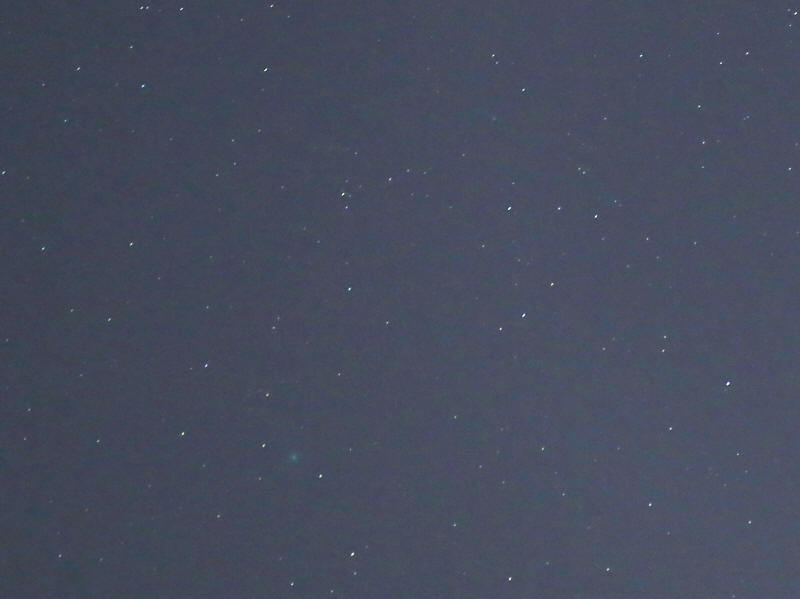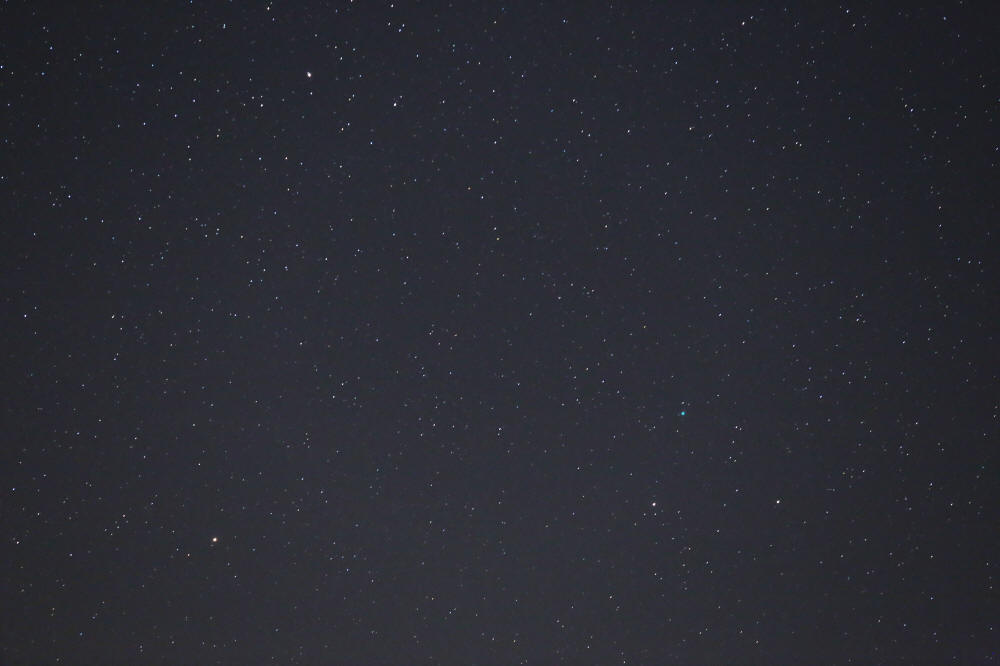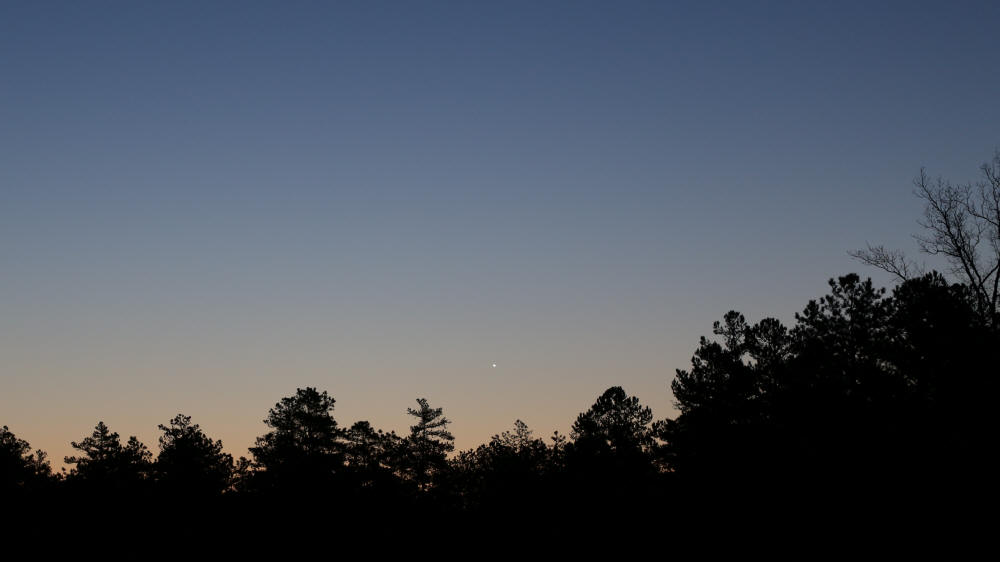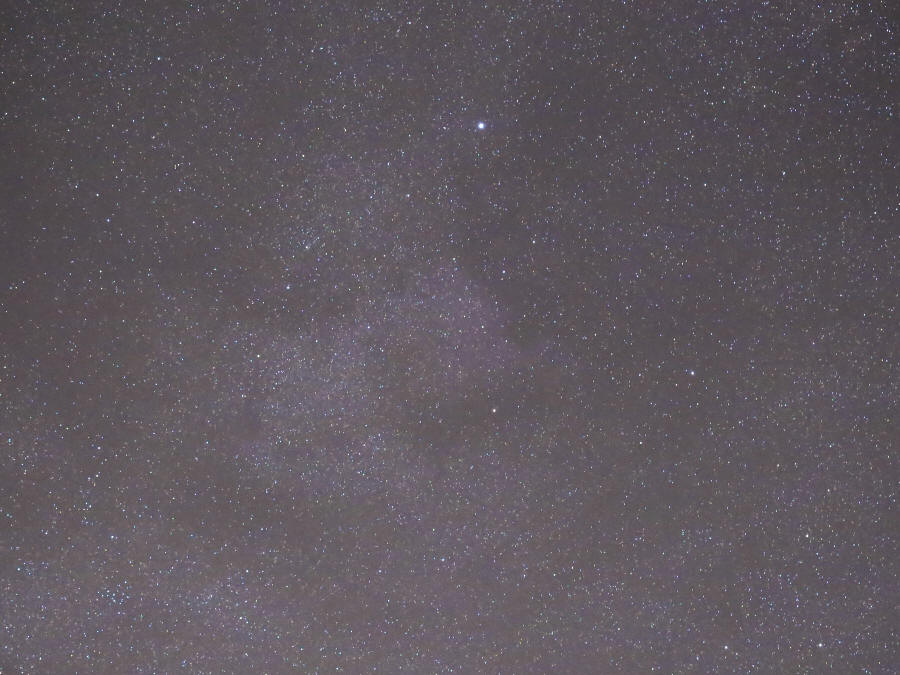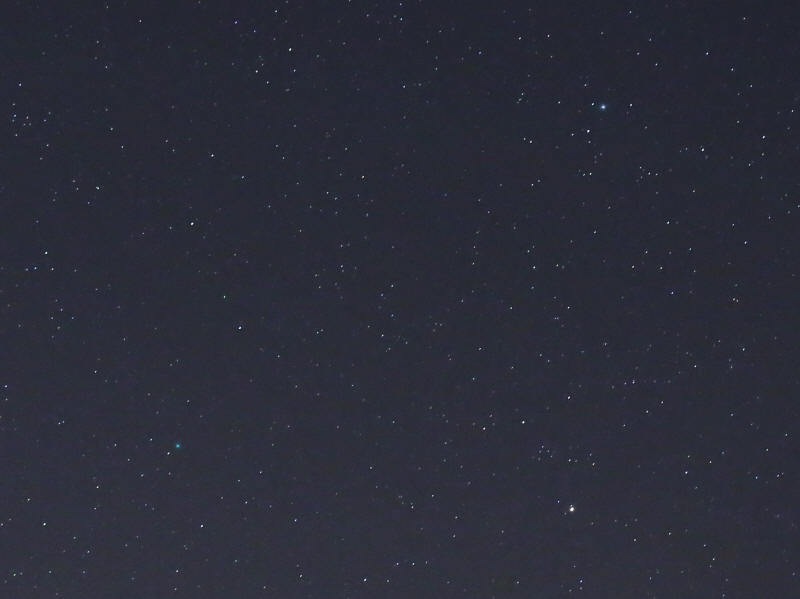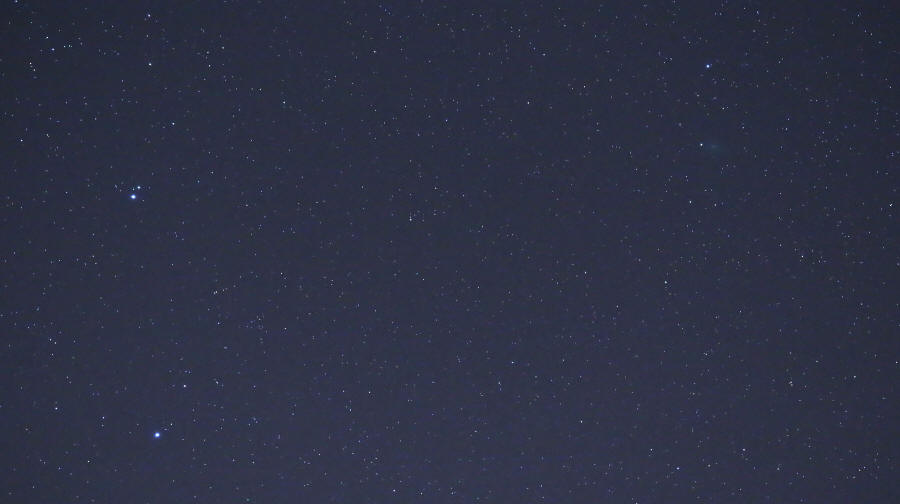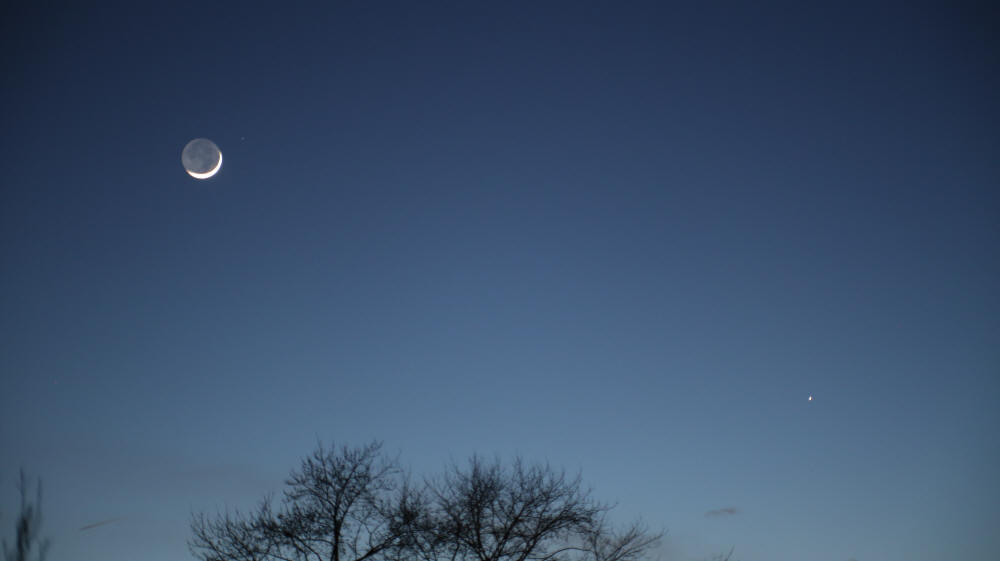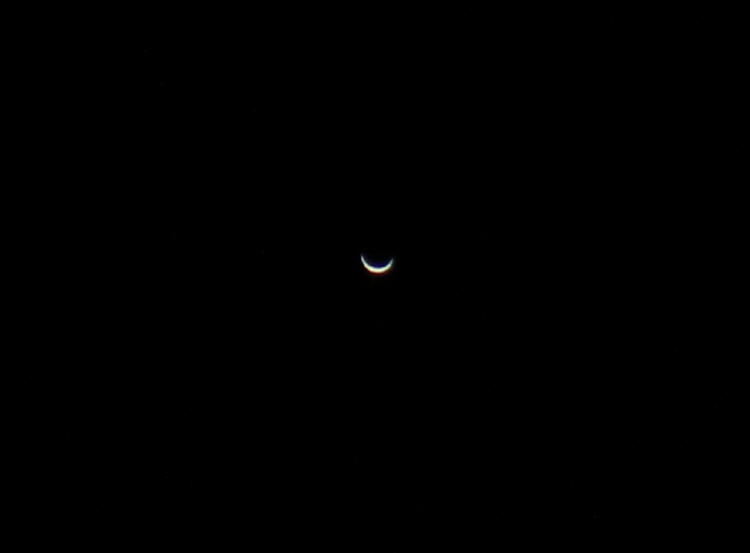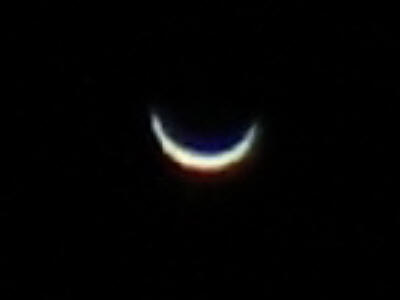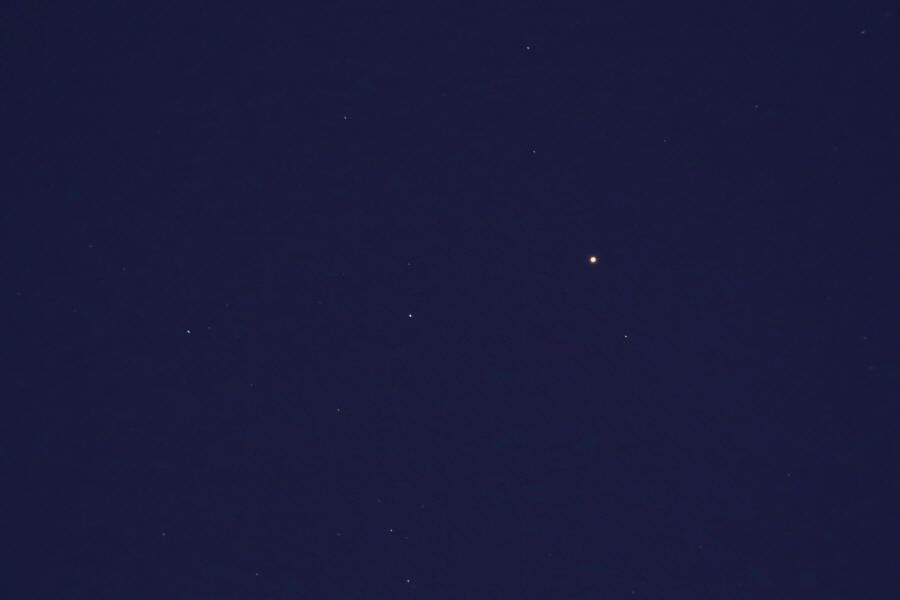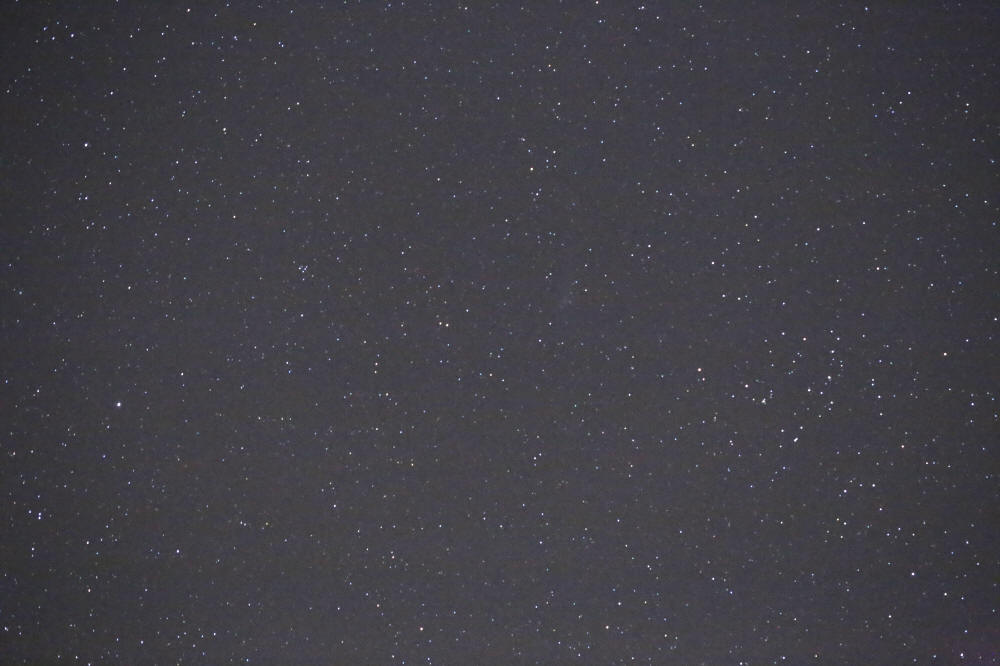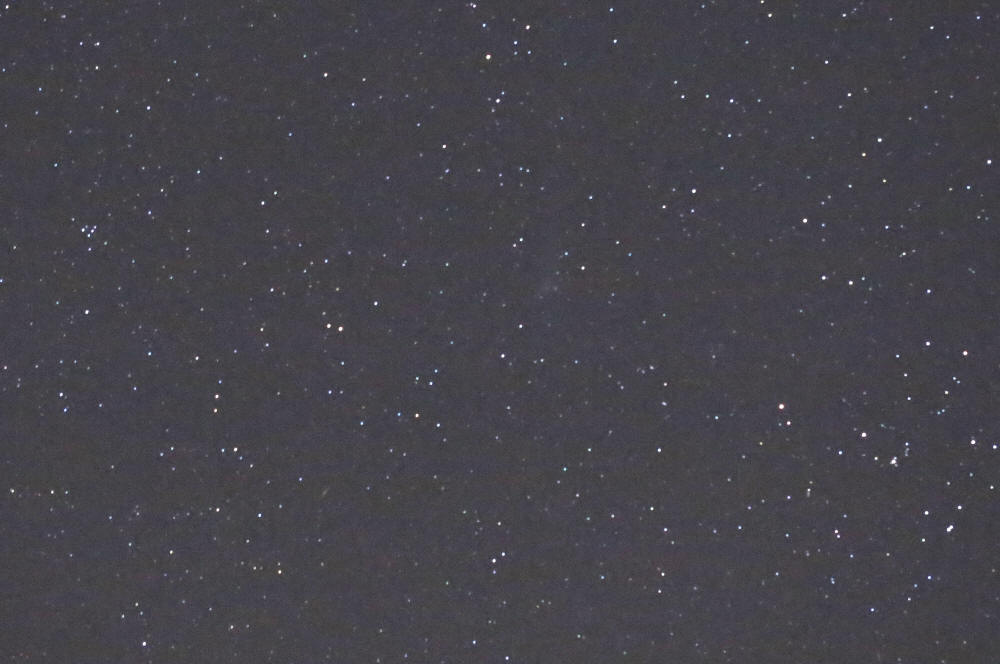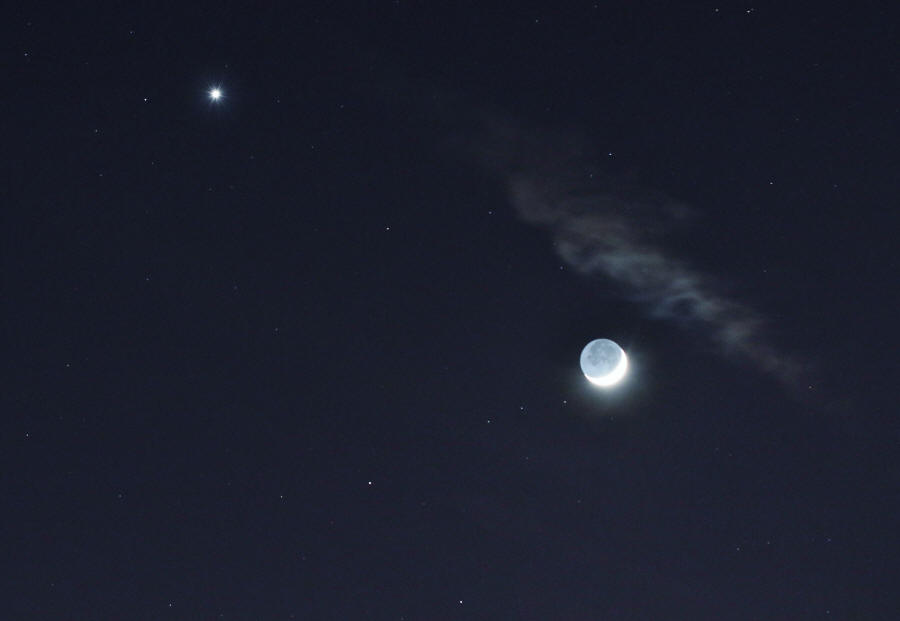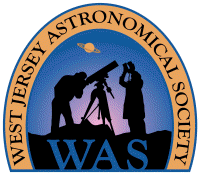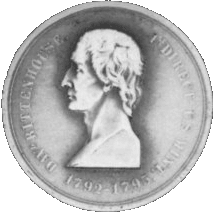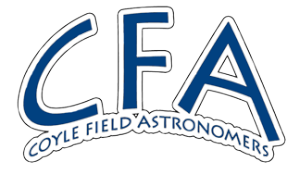Comet C/2015 ER61 (PANSTARRS)
April 8, 2017
I went to Borton Landing Road in Moorestown, NJ, on the morning of April 8, 2017, hoping to get a picture of comet C/2015 ER61 (PANSTARRS) while it was still in outburst. The sky above the horizon looked hazy, astronomical twilight began at 4:58 am EDT and the 92% illuminated moon set at 5:24 am. With 10x50 binoculars, I finally spotted comet C/2017 E4 (Lovejoy) at 5:00 am then PANSTARRS at 5:13 am. Both were fairly faint in the haze and the early part of twilight with residual moonlight. The picture above was captured at 5:19 am using a Canon 6D digital SLR camera and a Canon 70 to 200 mm f/2.8L zoom lens (on a fixed tripod) set to 200 mm focal length then cropped to a field 4.0° wide x 3.0° high. It's a single frame exposed 2 seconds at f/4, ISO 3200. Quality is poor, but PANSTARRS is visible. Mouseover for labels.
Binocular Comet Foursome
April 7, 2017
I headed back to Carranza Field on the morning of April 7, 2017, as it was the last day the waxing gibbous moon (85% illuminated) would set before the start of astronomical twilight (4:48 and 4:59 am EDT respectively) prior to full moon on April 11. In addition to the recently observed comets mentioned below, C/2015 ER61 (PANSTARRS), C/2017 E4 (Lovejoy) and 41P/Tuttle-Giacobini-Kresak, I also wanted to spot C/2015 V2 (Johnson) with binoculars. It was partly cloudy when I arrived at 4:20 am, then cleared, but complete cloud cover returned by 5 am. I had hoped to get a picture of PANSTARRS while still in outburst, but the southeast direction was the last to clear and first to cloud over again, so I was foiled. The snapshot above is Lovejoy taken at 4:52 am with a Canon 6D digital SLR camera and a Canon 70 to 200 mm f/2.8L zoom lens (on a fixed tripod) set to 200 mm focal length. It was exposed 4 seconds at f/4, ISO 6400. Mouseover for labels.
More importantly (to
me), all
four comets were ultimately seen with both 10x50 and 16x70 binoculars as
tabulated below with the initial sighting time.
|
Comet |
16x70 |
10x50 |
| C/2017 E4 (Lovejoy) | 4:25 am |
4:35 am |
| 41P/Tuttle-Giacobini-Kresak | 4:28 am |
4:35 am |
| C/2015 ER61 (PANSTARRS) | 4:32 am |
4:35 am |
| C/2015 V2 (Johnson) | 4:41 am |
4:55 am |
Lovejoy and PANSTARRS were easy to see (at least once once the clouds over PANSTARRS cleared). In all of my previous sightings, 41P was ghostly at best, but finally, in the window between moonset and the start of astronomical twilight, it was easy with the 16x70s and not difficult with the 10x50s. Johnson wasn't too difficult with 16x70s in that window, when it was finally visible with the 10x50s.
Another Binocular Comet
April 5, 2017
As noted on the comet e-groups in recent days, Comet C/2015 ER61 (PANSTARRS) has experienced an outburst to the magnitude 6.x range, so it's an easy binocular object. I saw it this morning, April 5, 2017, with 16x70 binoculars from my front yard a few minutes before the start of nautical twilight at 5:37 am EDT. It seemed a little brighter than nearby C/2017 E4 (Lovejoy). Here's Bob King's online article about it at Sky & Telescope.
Venus, the Morning Star
April 2, 2017
After sighting comet C/2017 E4 (Lovejoy) on April 2, 2017, as described below, twilight brightened and the starry sky disappeared. However, I waited for Venus to appear as a "morning star" following inferior conjunction eight days before on March 25. It rose at 5:39 am EDT and was spotted with unaided eyes at 5:55 am in the tree tops on the eastern end of Carranza Field at 2.9° altitude. This picture was captured at 6:01 am, 40 minutes before sunrise, when it was at 4° altitude. Taken with a Canon 6D digital SLR camera and a Canon 100 mm f/2.8L macro lens (on a fixed tripod), then cropped to about 16° wide x 9° high. Exposed 1/20 second at f/2.8, ISO 800, using auto white balance. Unfortunately, it was heavily overcast on the morning of March 25, so I didn't get to see Venus very close to the time of inferior conjunction. Since then, my only Venus sighting had been mid-day on March 29. Here's a summary of my Venus sightings near inferior conjunction.
The
North America Nebula
April 2, 2017
After taking comet pictures at Carranza Field on April 2, 2017 (scroll down for those), I noticed the Summer Triangle was high high in the northeast, so I took some shots around the first magnitude star Deneb and the North America Nebula (NGC 7000). I finally got around to looking at the non-comet pictures more closely, and posted the selected picture above on May 2. It's a single frame taken at 5:02 am EDT (two minutes before the start of astronomical twilight) with a Canon 6D digital SLR camera and a Canon 100 mm f/2.8L macro lens (on a fixed tripod), then cropped to about 14° wide x 10.5° high. Exposed 4 seconds at f/3.5, ISO 12800, using 3600K white balance. Mouseover for labels. 61 Cygni is particularly interesting in that it was the first star to have its parallax reliably measured.
Comet C/2017 E4 (Lovejoy)
April 2, 2017
My first sighting of Comet C/2017 E4 (Lovejoy) was accomplished with 16x70 binoculars on April 2, 2017, at 4:35 am EDT from Carranza Field in Wharton State Forest, NJ. This picture of it near Enif (Epsilon Pegasi, the nose of the Winged Horse) and the globular cluster Messier 15 was captured at 4:52 am when the comet at 17° altitude in the east. Taken with a Canon 6D digital SLR camera and a Canon 100 mm f/2.8L macro lens (on a fixed tripod). It was cropped to about 8.6° wide x 6.2° high. This is a single frame exposed 4 seconds at f/3.5, ISO 8000, using tungsten white balance. Mouseover for labels.
The comet was easy to see with the 16x70s, in contrast to comet 41P/Tuttle-Giacobini-Kresak that was spotted a minute before in Draco. The latter had a diffuse coma with low surface brightness while E4 was condensed with relatively high surface brightness. In the 16x70s, E4 looked similar to M15, but perhaps slightly dimmer. No tail or coma elongation was evident, and unlike its appearance in this image, E4 did not look greenish visually. It was not seen with unaided eyes. Bob King has an online article at Sky & Telescope about observing C/2017 E4 (Lovejoy).
The picture below shows Comet 41P/Tuttle-Giacobini-Kresak in Draco, across from the handle of the Big Dipper, at 4:58 am EDT, when it was at 55° altitude in the northwest. Taken with a Canon 6D digital SLR camera and a Canon 100 mm f/2.8L macro lens (on a fixed tripod). It was cropped to about 16.5° wide x 9.3° high. This is a single frame exposed 5 seconds at f/3.5, ISO 8000, using tungsten white balance. Mouseover for labels. 41P was previously seen in the bowl of the Big Dipper on March 22 at Belleplain State Forest with an 80 mm refractor and 10x50 binoculars.
The Crescent Moon and Mercury
March 29, 2017
The earthshine-filled Crescent Moon was about 45 hours old and 5.4% illuminated when it joined the planet Mercury in this picture captured on March 29, 2017, at 8:09 pm EDT. Taken from the old Collins Farm site in Maple Shade, NJ, with a Canon 6D digital SLR camera and a Canon 100 mm f/2.8L macro lens (on a fixed tripod) plus a Kenko 1.4x teleconvertor, providing an effective focal length of 140 mm. Exposed 1/3 second at f/4, ISO 1600. This is the best evening elongation of the year for Mercury because of the current steep angle of the ecliptic in the west after sunset. During the picture-taking session, Mercury (in Pisces) was easily visible with unaided eyes about 9½° from the moon, which was 5° south of the ecliptic in Cetus. The faint star off the upper-right limb of the moon is magnitude 4.3 Xi Ceti.
Venus Nears Inferior Conjunction
March 12, 2017
The planet Venus was less than two weeks from inferior conjunction (March 25, 2017, at 6:17 am EDT) when this picture of the 6.3% illuminated disc was captured at 7:45 pm EDT on March 12, 2017, from Maple Shade, NJ. Taken with a Canon 7D Mk II digital SLR camera and a Canon 400 mm f/5.6L telephoto lens (on a fixed tripod), plus a 1.4x Kenko teleconvertor, for an effective focal length of 560 mm. It was then cropped to about 16% of the horizontal dimension x 18% of the vertical direction of the original frame yielding a field 0.36° wide x 0.27° high. This single frame was exposed 1/8000 second at f/8, ISO 1600 (about one-third stop less than the "sunny sixteen rule" for earthbound subjects) using daylight white balance. Besides cropping and resizing, no processing was applied.
The image below is a more severe crop, roughly 2.5% of the original, providing a field about 3.5 x 2.6 arc minutes (and it magnifies the effects of imperfect seeing). Since Venus was 55.3 arc seconds apparent diameter at the time, the 560 mm focal length projected a 0.15 mm wide image onto the sensor, which is equivalent to 37 pixels at 4.09 μm per pixel for the 7D Mk II. Also note the coloring at the upper and lower edges of the crescent due to atmospheric chromatic aberration. At 7:45 pm, Venus was just 12° altitude (with a solar elongation of 20.6°). Finally, note that the cusps of the crescent point nearly straight up, perhaps tilted slightly to the right. Since the ecliptic is tilted a little left of vertical after sunset now, we might expect the cusps to be tilted a little left. However, the ecliptic latitude of Venus was +8.1°, so it's actually a little right of a vertical line from the sun perpendicular to the horizon (the horizontal edges of the frame were parallel to the horizon; the zenith is up).
On March 16, 2017, I went to the Maple Shade, NJ, baseball field complex to look at Venus after sunset again (the same session that I spotted Mercury for the first time of the second 2017 elongation). I initially saw Venus at 7:13 pm EDT with unaided eyes, shortly after arrival and shortly after sunset at 7:08 pm. The crescent was not visible with my unaided eyes, but easily seen with 16x70 and 10x50 binoculars. In both cases, it looked similar to the picture above, i.e., decidedly thicker than its 3.6% illumination would suggest (probably due to a combination of the great brilliance and the imperfect seeing at its 13° altitude). I was out again the following afternoon, March 17, and spotted Venus at 1:49 pm with 7x42 binoculars (the crescent was visible), but I could not see it with unaided eyes. At the time, Venus was about 15° from the sun at the 11 o'clock position (so I blocked the sun with my neighbor's house) and was at 61½° altitude, 185° azimuth. The Astronomy Picture of the Day for March 17, 2017, has an excellent illustration of Venus' changing phases.
On March 20, there were streaky clouds along the western horizon, but I went to the Maple Shade baseball field complex for a look anyway. I spotted the slim crescent of Venus at 7:10 pm EDT (two minutes before sunset) with 10x50 binoculars through thin patchy clouds, then lost it at 7:15 pm in a rising bank of thicker clouds. I was unable to find nearby Mercury, mainly because of the clouds. On March 21, I went back to the Maple Shade baseball field complex after noticing some clearing to the west at 7:30 pm. I found Venus in the tree tops at 7:40 pm with 10x50 binoculars and the crescent was easily visible. I then looked with unaided eyes and could see Venus, but no crescent. Next, I picked up Mercury at 7:44 with the 10x50s, then saw it with unaided eyes between scattered, streaky clouds.
On March 22, I initially spotted Venus at 1:07 pm EDT with 10x50 binoculars, 9½° directly above the sun, which was blocked by my neighbors house. Later in the day, viewing from the eastern side of the athletic field at Belleplain State Forest, NJ, I found Venus in my 80 mm apo refractor at 6:50 pm (24 minutes before sunset) not far above the tree tops on the western side of the field (I was there for a college student field trip). The slender crescent was quite lovely in the scope. The western tree line at Belleplain was around 6° apparent height, so Venus disappeared in the trees not long after 7 pm. It had not been seen with unaided eyes in the bright, whitish sky near the sun at the horizon. In contrast, higher Mercury was easily visible with unaided eyes when I looked for it at 7:45 pm. On March 23, I made my first morning observation of this Venus elongation. I went to the old Mart site in Pennsauken, NJ, and sweeping the horizon with 10x50 binoculars, I spotted Venus at 6:40 am, shortly after arrival. The crescent was distinct, although somewhat bloated by the low altitude, about 2¼° when found. I was subsequently able to glimpse Venus with unaided eyes in the brightening twilight (sunrise at 6:58 am). Therefore, I was able to see Venus at either end of the night of March 22/23 (at sunset and then again at the subsequent sunrise), thanks to its +8.4° ecliptic latitude. Unfortunately, on the morning of March 25 when inferior conjunction occurred at the same time as Venus rose (6:17 am EDT for 40°N-75°W), it was heavily overcast.
Here's a summary table of these sighting dates and times.
Mars and Uranus
February 26, 2017
The "Red Planet" Mars (magnitude 1.3) passed close to greenish-blue Uranus (magnitude 5.9) on February 26, 2017 (although the colors aren't very saturated in this non-processed image). The two planets were only 34 arc minutes apart when this image was captured at 6:44 pm EST from Maple Shade, NJ. At the time, Mars was at 30° altitude in the west-southwest during astronomical twilight. Taken with a Canon 7D Mark II digital SLR camera at the prime focus of a William Optics 80 mm, f/6 apo refractor on a fixed tripod. It was exposed 1 second at ISO 3200. The field is approximately 2.7° x 1.8°. Mouseover for labels. In the clear sky, Mars was easy to see with unaided eyes about 11° above-left of brilliant Venus, then Uranus was easy to see next to Mars with 10x50 binoculars.
Comet 45P/Honda-Mrkos-Pajdusakova
February 20, 2017
This image of the area around, and including, Comet 45P/Honda-Mrkos-Pajdusakova was captured at 12:18 am EST on February 20, 2017, from Carranza Field in Wharton State Forest, NJ. It's a single frame taken with a Canon 6D digital SLR camera and a Canon 100 mm f/2.8L macro lens on a fixed tripod. Exposed 4 seconds at f/3.5, ISO 20,000. Mouseover for labels.
After several unsuccessful attempts to spot 45P from the suburban area around my home in Maple Shade, NJ, last week (after its closest approach to earth on February 11, 2017, and the subsiding full moon of February 10), I finally got to see it again after last spotting it after sunset around New Year's Day 2017 (see below). In my 85 mm spotting scope, I picked it up at 11:55 pm EST on February 19. It was just a dim glow at lowest power (27x) and it almost faded away at maximum power (60x). There seemed to be some elongation in a roughly ENE-WSW direction, but no tail was evident. The galaxy NGC 4414 (magnitude 11) was a visible smudge within the coma of 45P, roughly SSW of the comet's apparent center, which is only an arc minute from the borderline between Canes Venatici and Coma Berenices. NGC 4414 is about 6 arc minutes on the other side of the border.
The image below is an nominal 57% crop of the original image above to better show the comet, the galaxy and a short green line indicating the approximate elongation (mouseover for labels). It spans about 11.6° x 7.8° (vs. 20.3° x 13.6° for the original). Since it was exposed at a relatively high ISO 20,000 (necessitated by the comet's low surface brightness), there's a very noticeable amount of noise in this single frame. The greenish color of the coma as seen in better images is absent here, and it was not detected visually either.
The Crescent Moon, Venus and a Comet Open the New Year
January 1, 2017
The Crescent Moon was 13% illuminated when this picture of it was captured at 5:54 pm EST on January 1, 2017, from Maple Shade, NJ. Of course, we see the whole disc since the remainder is illuminated by earthshine (and the illuminated portion is greatly overexposed to bring out the earthshine, as well as the field stars). The planet Venus is 56% illuminated as it nears Greatest Eastern Elongation on January 12th, but it too is greatly overexposed, and too small at this scale, to show its gibbous shape. Taken with a Canon 7D Mk II digital SLR camera and a Canon 100 mm f/2.8L macro lens, then cropped to about 85% of the original size for a field 10.6° wide x 7.4° high. Exposed 1 second at f/4, ISO 1600. Mouseover for labels.
Comet 45P/Honda-Mrkos-Pajdusakova was about 11° from the Crescent Moon at the 5 o'clock position when this picture was captured at 6:07 pm EST on January 1, 2017, from Maple Shade, NJ. The comet was in the 7.x magnitude range, which is relatively bright as far as typical comets go, but because of its low altitude (just under 11° at the time), a little moon glow plus suburban light pollution (this site is 8 miles east of center-city Philadelphia), it was still a quarter-hour before the end of astronomical twilight and that the atmosphere was slightly hazy meant the comet presented low contrast in the sky. It was just a vaguely visible smudge both visually with 16x70 binoculars and in this image. Taken with a Canon 7D Mk II digital SLR camera and a Canon 100 mm f/2.8L macro lens, then cropped to about 50% of the original size for a field 6° wide x 4° high. Exposed 1 second at f/4, ISO 1600. Mouseover for labels.
Click here for some older images.
